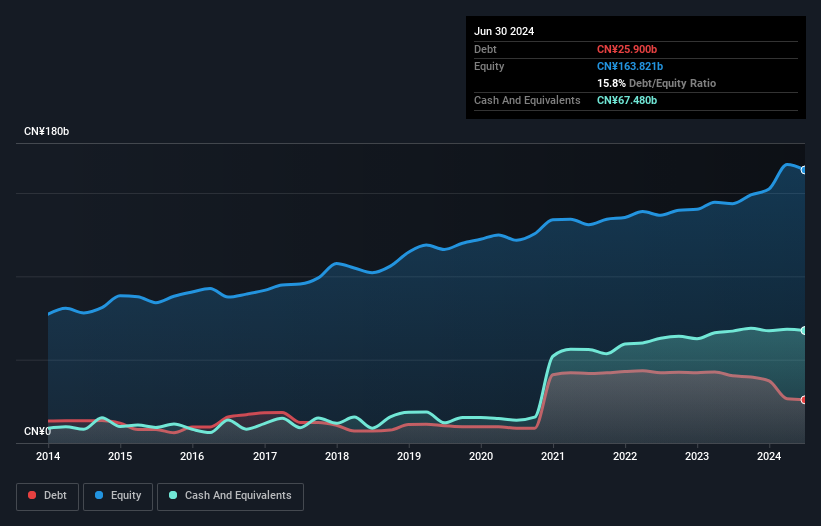- China
- /
- Transportation
- /
- SHSE:601006
These 4 Measures Indicate That Daqin Railway (SHSE:601006) Is Using Debt Reasonably Well

Legendary fund manager Li Lu (who Charlie Munger backed) once said, 'The biggest investment risk is not the volatility of prices, but whether you will suffer a permanent loss of capital.' It's only natural to consider a company's balance sheet when you examine how risky it is, since debt is often involved when a business collapses. We note that Daqin Railway Co., Ltd. (SHSE:601006) does have debt on its balance sheet. But the more important question is: how much risk is that debt creating?
When Is Debt A Problem?
Debt assists a business until the business has trouble paying it off, either with new capital or with free cash flow. If things get really bad, the lenders can take control of the business. While that is not too common, we often do see indebted companies permanently diluting shareholders because lenders force them to raise capital at a distressed price. By replacing dilution, though, debt can be an extremely good tool for businesses that need capital to invest in growth at high rates of return. The first step when considering a company's debt levels is to consider its cash and debt together.
See our latest analysis for Daqin Railway
What Is Daqin Railway's Net Debt?
As you can see below, Daqin Railway had CN¥25.9b of debt at June 2024, down from CN¥40.3b a year prior. But on the other hand it also has CN¥67.5b in cash, leading to a CN¥41.6b net cash position.

How Healthy Is Daqin Railway's Balance Sheet?
According to the last reported balance sheet, Daqin Railway had liabilities of CN¥20.2b due within 12 months, and liabilities of CN¥28.2b due beyond 12 months. Offsetting these obligations, it had cash of CN¥67.5b as well as receivables valued at CN¥14.2b due within 12 months. So it can boast CN¥33.2b more liquid assets than total liabilities.
This excess liquidity suggests that Daqin Railway is taking a careful approach to debt. Given it has easily adequate short term liquidity, we don't think it will have any issues with its lenders. Simply put, the fact that Daqin Railway has more cash than debt is arguably a good indication that it can manage its debt safely.
But the other side of the story is that Daqin Railway saw its EBIT decline by 9.6% over the last year. If earnings continue to decline at that rate the company may have increasing difficulty managing its debt load. When analysing debt levels, the balance sheet is the obvious place to start. But ultimately the future profitability of the business will decide if Daqin Railway can strengthen its balance sheet over time. So if you're focused on the future you can check out this free report showing analyst profit forecasts.
Finally, a company can only pay off debt with cold hard cash, not accounting profits. While Daqin Railway has net cash on its balance sheet, it's still worth taking a look at its ability to convert earnings before interest and tax (EBIT) to free cash flow, to help us understand how quickly it is building (or eroding) that cash balance. Over the most recent three years, Daqin Railway recorded free cash flow worth 60% of its EBIT, which is around normal, given free cash flow excludes interest and tax. This cold hard cash means it can reduce its debt when it wants to.
Summing Up
While we empathize with investors who find debt concerning, you should keep in mind that Daqin Railway has net cash of CN¥41.6b, as well as more liquid assets than liabilities. So we don't think Daqin Railway's use of debt is risky. There's no doubt that we learn most about debt from the balance sheet. However, not all investment risk resides within the balance sheet - far from it. We've identified 2 warning signs with Daqin Railway , and understanding them should be part of your investment process.
When all is said and done, sometimes its easier to focus on companies that don't even need debt. Readers can access a list of growth stocks with zero net debt 100% free, right now.
New: Manage All Your Stock Portfolios in One Place
We've created the ultimate portfolio companion for stock investors, and it's free.
• Connect an unlimited number of Portfolios and see your total in one currency
• Be alerted to new Warning Signs or Risks via email or mobile
• Track the Fair Value of your stocks
Have feedback on this article? Concerned about the content? Get in touch with us directly. Alternatively, email editorial-team (at) simplywallst.com.
This article by Simply Wall St is general in nature. We provide commentary based on historical data and analyst forecasts only using an unbiased methodology and our articles are not intended to be financial advice. It does not constitute a recommendation to buy or sell any stock, and does not take account of your objectives, or your financial situation. We aim to bring you long-term focused analysis driven by fundamental data. Note that our analysis may not factor in the latest price-sensitive company announcements or qualitative material. Simply Wall St has no position in any stocks mentioned.
About SHSE:601006
Daqin Railway
Provides railway transportation services in the People’s Republic of China and internationally.
Excellent balance sheet and slightly overvalued.
Market Insights
Community Narratives



